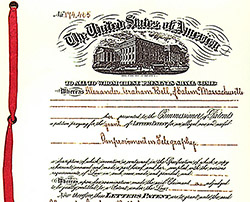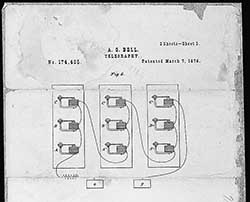Electronic Communication
This chapter covers the invention of, first, wired communication with an electric current—the telegraph and then the telephone—and then wireless communication, leading to radio and television, which also resulted in mobile phones. The development of media to record electronic information is also covered, including its use for audio and video.
TOPICS
• Electronic components: Coherers, crystals, vacuum tubes, transistors, integrated circuits
• Electronic devices: Telegraph, telephone, radio, TV, audio, magnetic tape
• The telegraph: optical, electric, international lines
• The telephone: Bell, AT&T, infrastructure, mobile, cellular
• Radio: Inventors, Golden Age, broadcasting technology
• Television: Cathode ray tube, mechanical, electronic, first broadcasts, color
• Broadcast networks, satellites, fiber optical cable
• Audio: Mechanical, gramophone, electric, movie sound
• Microphones, speakers
• Magnetic tape: audio and video
• The age of electronic communication
• Crystal radio set
• Vacuum tubes
• Junction transistor
• Integrated circuit
• Electronic components
• Electronic devices timeline
• Telegraph - 2 panels
• International telegraph lines, 1891 map
• Bell first telephone
• Rotary phone dial
• Motorola DynaTAC 8000x
• Cellular network
• Regency TR-1
• Broadcasting technology
• Color cathode ray picture tube
• Assigned broadcast frequencies
• Fiber optic cables
• Mechanical sound recording
• Electronic turntable/record grooves
• Record sizes
• Microphones
• Speakers
• Magnetic tape
• Television ownership in the US
• Hours of television watched per day in the US
• US average weekly movie attendance
• 1910 first rotary phone advertisement
• Motorola MicroTAC
• Hedy Lamarr portrait
• Alexanderson alternator
• Brant Rock radio station
• Edison wax cylinder phonograph
• Mechanical gramophone
• Shure 55 microphone
• Compact cassette
• 1979 Sony Walkman
The field of electronics is about controlling an electric current, to not only start and stop it but to alter its characteristics: To vary its power and frequency, in order to make machines do specific tasks.
As we discussed previously, the practical use of electricity began in the 19th century with the first electric motors and generators, the lightbulb, and power grids. The first use of electricity for communication was the telegraph, an early 19th-century invention. But all of these uses only needed a steady electric current that was simply switched on and off.
The discovery that an electric current creates a field around it consisting of radio waves inspired many inventors with the possibility of wireless communication, and its pursuit led to a greater understanding of how electricity works, and the necessity of modulating it in order to achieve this goal. This led to the discovery of the first semi-conductors, which allowed a weak current to control a strong one—necessary for broadcasting a radio signal—and ways to modify the signal to allow it to carry sound. These discoveries led to the invention of the radio, followed by television.
The pursuit of ways of recording sound also began in the 19th century, and was at first purely mechanical, but in time was converted to an electric pattern, allowing it to be synced with movies, and then combined with TV broadcast signals.
By mid-20th century magnetic tape made it easier to record both audio and video, making content production easy and affordable.
And then came the silicon microchip and integrated circuits, which made available to the public a vast range of portable and affordable electronic devices in the second half of the century.
Electronics radically changed the way the public accessed information and communicated with each other, even before the Digital Age. Radio, TV, movies and audio media had profound societal influences unlike any prior era.
Documentary
Shock and Awe: The Story of Electricity. BBC 2011.
Vacuum tube
How Semiconductors Work. Marshall Brain, howstuffworks.com, Feb. 11, 2021.
How Does a Vacuum Tube Work. electronics-notes.com.
Vacuum Tubes: The World Before Transistors. Michael Alba, engineering.com, Jan. 18, 2018.
The First Vacuum Tube – History of the Thermionic Tube. history-computer.com.
The Vacuum Tube. pbs.org.
Who Invented the Diode? David Laws, computerhistory.org, Nov. 6, 2013.
Transistor
Who Invented the Transistor? David Laws, computerhistory.org, Dec. 4, 2013.
Transistors. Chris Woodford, explainthatstuff.com, Sept. 21, 2020.
Largest Chip Ever Holds 1.2 Trillion Transistors. Al Williams, hackaday.com, Aug. 21, 2019.
Transistor Count Trends Continue to Track with Moore’s Law. icinsights.com, Mar. 05, 2020.
Point Contact Transistor. pbs.org.
The History of the Transistor. Thayer Watkins, Dept. of Economics, San José State University.
World’s Smallest Transistor Is Cool but Won’t Save Moore’s Law. Jamie Condliffe, MIT Technology Review, Oct. 7, 2016.
Transistor count. wikiwand.com.
Integrated circuit
The History of the Integrated Circuit. anysilicon.com.
The History of Circuit Boards. Nicole Hall, falconerelectronics.com, Aug. 18, 2017.
Symbols
100+ Electrical & Electronic Circuit Symbols. electronicshub.org, Mar. 19, 2021.
Electrical Symbols & Electronic Symbols. rapidtables.com.
Telegraph
Dr E.O.W. Whitehouse and the 1858 trans-Atlantic Cable. D. de Cogan, History of Technology, 1985.
Morse Code & the Telegraph. history.com, June 6, 2019.
The Telegraph. David J Gagnon, members.kos.net.
What the Digital Age Owes to the Inventor of Morse Code. Sean Trainor, Time, April 27, 2016.
Last telegram ever to be sent July 14. Chenda Ngak, CBS News, June 12, 2013.
I Tried to Send a Telegram in 2016. Adrienne LaFrance, The Atlantic, Jan. 22, 2016.
Telephone
A look at the evolution of the Dial Telephone. William Lee Roberts, arctos.com, 2004.
Alexander Graham Bell: Inventor Of The Telephone, International Hero. Karen Harris, historydaily.org, March 7, 2020.
First Official Transatlantic Telephone Call (January 7, 1927). PDF. Cary O’Dell, Library of Congress.
History of the Telephone. Jason Morris, Independent Telecommunications Pioneer Association.
An Early History of the Telephone 1664-1866. Daniel P McVeigh, oceanofk.org.
Telephone History. Thomas Farley, privateline.com, Jan. 2016.
The Pay Phone’s Journey From Patent to Urban Relic. Jimmy Stamp, Smithsonian Magazine, Sept. 18, 2014.
History of the Rotary Phone. Jason Isbell, techwalla.com.
When the first public transatlantic phone service came into operation. The Telegraph, Jan. 13, 2017.
How AT&T Conquered The 20th Century. Matthew Lasar, wired.com, Sept. 3, 2011.
Mobile phone
The First Mobile Phone Call Was Made 40 Years Ago Today. Zachary Seward, The Atlantic, April 3, 2013.
The first mobile phone call was placed 40 years ago today. Fox News, Nov. 5, 2015.
Motorola MicroTAC 9800X. mobilephonehistory.co.uk.
Motorola MicroTAC. wikivisually.com.
Mobile network
Cell phone industry celebrates its 25th birthday. Marguerite Reardon, CNET, Oct. 13, 2008.
What is 5G? Your questions answered. Clare Duffy, CNN, March 6, 2020.
What is 5G? Sascha Segan, PC Magazine, Feb. 25, 2021.
Our reliance on cellphones began 35 years ago today. Jane C. Hu, Quartz, Oct. 13, 2018.
Radio
James C. Maxwell. biography.com, April 2, 2014.
James Clerk Maxwell: a force for physics. Francis Everitt, Physics World, Dec. 1, 2006.
Heinrich Hertz and electromagnetic radiation. Steven A. Edwards, aaas.org, Oct. 12, 2012.
Heinrich Hertz. famousscientists.org. Nov. 23, 2015.
Heinrich Rudolph Hertz. Michael W. Davidson, Florida State University, Nov 13, 2015.
Oliver Lodge. ethw.org, Feb. 11, 2016.
Nikola Tesla, My Inventions: The Autobiography of Nikola Tesla. Hart Brothers 1982.
Tesla: Man Out of Time. Margaret Cheney, Touchstone 1981.
Tesla gives 1st public demonstration of radio, March 1, 1893. Suzanne DeFree, edn.com, March 1, 2019.
Tesla’s toy boat: A drone before its time. J. Turi, engadget.com, Jan. 19, 2014.
1893: Tesla stuns a St. Louis crowd with his first demonstration of radio. St. Louis Post-Dispatch archives, March 1, 2021.
Tesla Coil. Griffith Observatory.
Tesla Coil. Tesla Memorial Society of New York.
The Alexanderson transmitter. The Alexander association.
O Holy Night: The Father of Radio and the First Radio Broadcast. Sam Sattel, autodesk.com.
Reginald Fessenden: The Father of Radiotelephony. Christopher McFadden, interestingengineering.com, Jan. 31, 2018.
First Radio Broadcast Christmas Eve 1906. Bob Underdown, youtube.com.
First radio transmission sent across the Atlantic Ocean. history.com, Feb. 9, 2010.
Faking the waves. Laurie Margolis, The Guardian, Dec. 11, 2001.
Marconi receives radio signal over Atlantic 1901. pbs.org.
Who Invented Radio? pbs.org.
Marconi and the invention of radio (1915-1943) The Guardian, Aug. 6, 2007.
Tesla, Marconi, and the Great Radio Controversy: Awarding Patent Damages without Chilling a Defendant’s Incentive to Innovate.PDF. Christopher A. Harkins, Columbia Law Review, Vol. 73 Issue 3 Summer 2008.
Titanic. history.com, Nov. 9, 2009.
Titanic Survivors - Names of all passengers and crew that survived. encyclopedia-titanica.org.
Radio broadcasting
Wireless Basics: How Radio Waves Work. Sam Sattel, autodesk.com, 2016.
Crystal radio set. chegg.com.
Electromagnetic Spectrum. cusustainableenergy.pbworks.com.
Radio Electronics: Transmitters and Receivers. Doug Lowe, dummies.com.
The History of the Radio Industry in the United States to 1940. Carole E. Scott, State University of West Georgia. Website: Economic History Association.
Modulation and Different Types of Modulation. electronicshub.org, August 28, 2015.
Radio 1929-1941. encyclopedia.com.
Radio Spectrum Allocation. US Federal Communications Commission.
AM and FM Radio Frequencies. hyperphysics-Georgia State University.
Understanding How AM/FM Radio Works. Gary Altunian, lifewire.com, Jan. 28, 2021.
United Kingdom Office of Communications. ofcom.org.uk.
Regency TR-1 Transistor Radio History. Don Pies, regencytr1.com.
The Transistor Radio Launches the Portable Electronic Age. Joseph Stromberg, Smithsonian Magazine, Oct. 18, 2011.
The Complete Guide on How to Build a Crystal Radio—Plus How They Work. Austin Shirkin, steampunk.wonderhowto.com, Jan. 3, 2018.
History of the Radio: From Inception to Modern Day. techwholesale.com.
Tesla’s Dream: The World System of Wireless—Part 1. Henry M. Bradford, teslauniverse.com, Feb. 1999.
United States Frequency Allocations. US Dept. of Commerce/National Telecommunications and Information Administration/Office of Spectrum Management.
Statistics on Radio. Unesco 2017.
Television
John Logie Baird (1888 - 1946). BBC 2014.
History of the Television. Johnson Hur, bebusinessed.com 2019.
Early Color Television. Early Television Museum.
How Television Works. Marshall Brain, howstuffworks.com.
Mechanical Television. Early Television Museum.
CBS Corporation. Harold L. Erickson, britannica.com, July 20, 1998.
American Broadcasting Company. wikipedia.org.
PBS. wikipedia.org.
Our History. NBC Universal.
Columbia Broadcasting System. New World Encyclopedia.
Number of commercial TV stations in the United States from 1950 to 2017. statista.com.
The Decline in Average Weekly Cinema Attendance: 1930 -2000. Michelle Pautz, Issues in Political Economy, 2002, Vol. 11.
Television Facts and Statistics—1939 to 2000. tvhistory.tv.
Number of TV Households in America 1950-1978. Grant Cokeley, The American Century, Washington & Lee University.
Television. Bill Ganzel, the Ganzel Group 2007.
The State of Traditional TV: Updated With Q2 2017 Data. marketingcharts.com.
Ownership of TV Sets Falls in U.S. Brian Stelter, The New York Times, May 3, 2011.
Daily time spent watching TV per capita in the United States from 2014 to 2022. statista.com.
How the World Consumes Media—in Charts and Maps. Derek Thompson, The Atlantic, May 28, 2014.
When Did TV Watching Peak? Alexis Madrigal, The Atlantic, May 30, 2018.
A history of television, the technology that seduced the world—and me. Andrew Anthony, The Guardian, Sept. 7, 2013.
Next year, people will spend more time online than they will watching TV. That’s a first. Rani Molla, Vox, June 8, 2018.
Cathode ray tube
The Cathode Ray Tube. howstuffworks.com.
Cathode-ray tube. wikipedia.org.
Super Mario Played Back at 380,000 FPS Reveals What’s Really Going On. Ambrose Leung, hypebeast.com, Jan. 19, 2018.
Television History and the Cathode Ray Tube. Mary Bellis, thoughtco.com, April 6, 2017.
Satellite
Telstar 1 Legacy: 1st Live TV Broadcast by Satellite Turns 50. space.com 2012.
Fiber optics
City of Light: The Story of Fiber Optics. Jeff Hecht, Oxford University Press 2004.
Fiber Optics Technician&s Handbook. Jim Hayes, Delmar Publishers 2001.
Fiber-Optic Technologies. Vivek Alwayn, Cisco Press 2004.
Attenuation. wikipedia.org.
Fiber Optic History. Jeff Hecht, Fiber Optics Technician&s Handbook, jeffhecht.com.
The Incredible International Submarine Cable Systems. Michael Morris, Network World, April 19, 2009.
Fiber Optic Cable History. tevelec.com.
History of Fiber Optics. Jim Johnson, timbercon.com, Oct. 18, 2018.
How Fiber Optics Was Invented. Mary Bellis, thoughtco.com, June 30, 2019.
Vinyl
The History of Vinyl. The Vintage Record, americanhistorynow.org, Jan. 27, 2014.
Microphone
Simplified Electronics #1: Microphone (How it works & DIY Microphone).(YouTube) AH Electronics.
Electret Condenser Microphones.cuidevices.com.
Shure.wikipedia.org.
Speakers
How Do Speakers Work: Understanding Audio Reproduction (Infographic). Rory Seydel, landr.com, July 18, 2017.
History and Types of Loudspeakers. M.W. and S. Normandin, Edison Tech Center 2015.
Loudspeakers. Chris Woodford, explainthatstuff.com, Jan. 9, 2020.
How do speakers work? AJ Wykes, soundguys.com, March 12, 2021.
History of the Loudspeaker Mary Bellis, thoughtco.com, Feb. 20, 2018.
Magnetic tape
Analog Tape Recorders. artsites, UC Santa Cruz.
Magnetic Recording Technology. MW and W.Kornrumpf, Edison Tech Center.
Magnetic Tape. Today&s Engineer, Feb. 2005.
Telegraphone. ethw.org, April 12, 2017.
Tape Head Action. hyperphysics.phy-astrgsu.edu. Georgia State University.
How does magnetic tape work? The Basics. Dante Fumo, reverb.com, March 31, 3018.
Tape Recording: Taking the Electromagnet to a Whole New Level. (YouTube) Technology Connections, Feb. 13, 2016.
Sony Walkman
The Walkman, Forty Years On. Matt Alt, The New Yorker, June 29, 2020.
NOTE: Weblinks were current and active at the time of the last update to the site, but may have since become unavailable or outdated. If you encounter a dead link, please notify me at phil.loubere@mtsu.edu. Thanks.
Last update: May 2021
Content related to this chapter’s topics will be periodically posted here.
Electricity

Shock and Awe: The Story of Electricity. Jim Al-Khalili, BBC Horizon, 2011.
This BBC documentary covers the sequence of discoveries that led to the Age of Electronics.
Bell’s Patent
Mechanical TVs
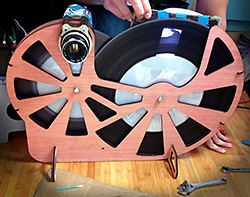
Mechanical TV and Camera. William Osman, williamosman.com.
The first TVs were mechanical, using spinning disks to create moving images. This blogger shows how they work and how to build one.
TV in slow motion
How a TV Works in Slow Motion. This video demonstrates through the use of a high-speed camera how both CRT and LCD screens are refreshed pixel by pixel.
Earliest sound recording
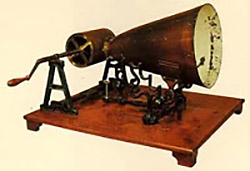
1860 'Phonautograph' Is Earliest Known Recording. NPR, April 4, 2008.
The 'phonautograph' was patented in 1857 by Edouard-Leon Scott de Martinville, preceding Edison’s phonograph by 20 years. This article has links to two sound files of early recordings.
Broadcasting sound with radio waves
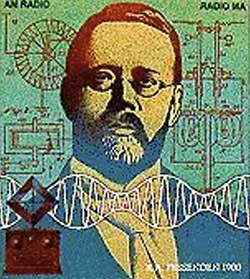
Reginald Fessenden and the Physics of the First Radio Broadcast. Kathy Joseph, kathylovesphysics.com.
Why was AM radio created and how? It all began in 1899 when a Canadian scientist heard a particular buzzing sound and decided that sound could be transferred wirelessly and ended in 1906 with the Alexanderson alternator and the electrolytic detector and a "perfect" wireless transfer of sound.
The invention of TV

The Farmboy Who Invented Television. Kat Eschner, Smithsonian Magazine, Aug. 28, 2017.
The inventor of television’s career presages many of the good and bad things about Silicon Valley.
Homemade microphones
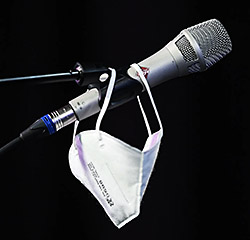
How to Make a Microphone … From a Face Mask. Rhett Allain, Wired Magazine, May 27, 2022.
The results won’t be high fidelity, but you can definitely turn sound into electric signals using an N95 and some physics knowledge.
Last update: June 2022




